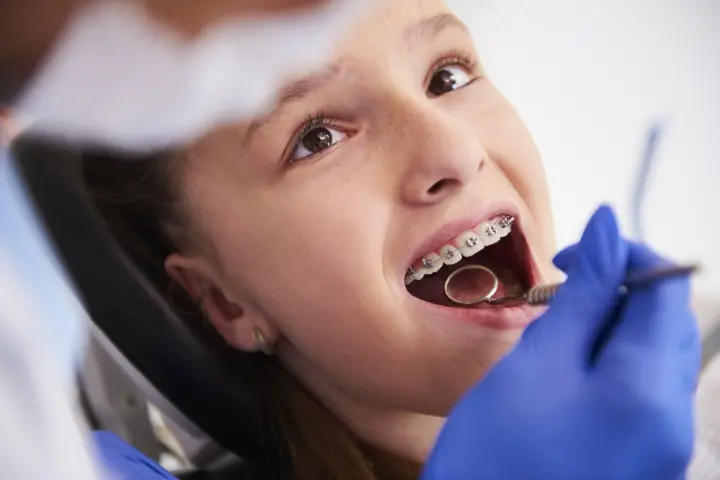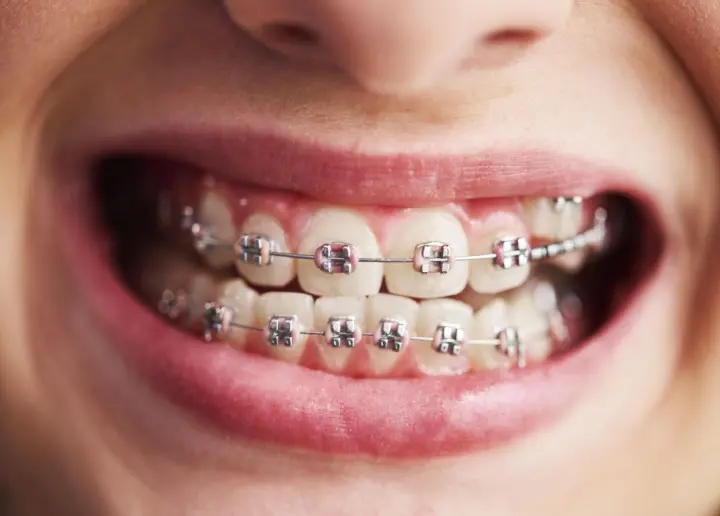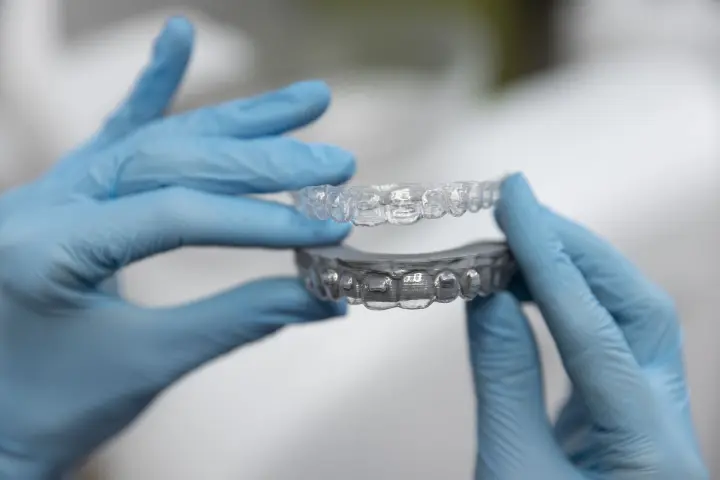The journey to a straighter smile presents an important crossroad for many patients: choosing between innovative clear aligner therapy like Invisalign or conventional metal braces. This decision extends far beyond aesthetics, involving considerations about lifestyle, treatment efficiency, and specific orthodontic needs.
At Vident Dental Clinic, we believe informed decisions lead to superior outcomes. This comprehensive comparison explores the key differences between these orthodontic approaches to help you determine which option aligns best with your unique circumstances.
Understanding the Fundamental Differences
Both Invisalign and traditional braces share the same ultimate goal—creating properly aligned teeth and an optimal bite relationship. However, they achieve this through distinctly different mechanisms and materials.
Traditional Braces: The Established Approach
Conventional braces consist of several components working in concert:
- Brackets: Small metal, ceramic, or composite attachments bonded directly to each tooth
- Archwires: Flexible metal wires that thread through brackets and guide tooth movement
- Ligatures: Small elastic bands that secure the archwire to brackets (self-ligating brackets eliminate this component)
- Auxiliary appliances: Springs, bands, or headgear that address specific movement requirements
This system creates continuous pressure that gradually shifts teeth into their desired positions through bone remodeling—a process where bone tissue dissolves and reforms around moving teeth.
Invisalign: The Contemporary Alternative
Invisalign represents a fundamentally different approach:
- Custom aligners: Series of clear, removable thermoplastic trays created from digital models
- SmartTrack material: Proprietary polymer that applies precise, controlled force
- Attachments: Small tooth-colored composite shapes bonded to specific teeth when needed
- Digital planning: Computer-designed movement sequence mapped from start to finish
This system relies on a series of incrementally different aligners (typically changed every 1-2 weeks) that progressively guide teeth toward their final positions.
Clinical Considerations: Which Cases Are Ideal for Each Option?
The scope and complexity of your orthodontic needs significantly influence which treatment might be more appropriate.
Scenarios Where Traditional Braces Often Excel
- Complex bite issues: Significant overbites, underbites, or crossbites often respond better to the precise control of conventional brackets and wires
- Severe rotations: Teeth requiring more than 20 degrees of rotation may benefit from the direct grip that brackets provide
- Significant vertical movements: Raising or lowering teeth in the jawbone (extrusion/intrusion) can be challenging with aligners alone
- Multi-directional corrections: Cases requiring simultaneous movement in multiple planes often benefit from traditional mechanics
Scenarios Where Invisalign Often Shines
- Mild to moderate crowding or spacing: Cases requiring primarily horizontal movement respond excellently to aligner therapy
- Relapse after previous orthodontics: Adults who experienced shifting after earlier treatment often make ideal candidates
- Specific aesthetic concerns: Targeted improvements focusing on the visible front teeth typically work well with aligners
- Periodontal considerations: Patients with mild gum disease often benefit from the improved oral hygiene possible with removable aligners
The Evolution of Capabilities
It's worth noting that Invisalign's capabilities have expanded significantly in recent years. The introduction of features like mandibular advancement for adolescents, precision cuts for elastics, and specialized attachment designs has broadened the range of cases appropriate for aligner therapy.
A 2021 systematic review in the Journal of Clinical Orthodontics found that modern aligner systems can effectively address approximately 80% of common orthodontic issues when treatment is planned and executed by experienced providers.
Treatment Experience: Day-to-Day Differences
Perhaps the most noticeable distinctions between these options relate to the daily experience throughout treatment.
Visibility and Aesthetics
The most obvious difference involves appearance:
- Traditional braces: Remain visible throughout treatment, though ceramic or lingual (behind-the-teeth) options offer reduced visibility at additional cost
- Invisalign: Nearly invisible in most social situations, with clear aligners that are difficult to detect during casual interaction
A 2023 study in the Journal of Aesthetic Dentistry found that 87% of adults surveyed rated the aesthetic impact of treatment as "very important" or "extremely important" in their orthodontic decision-making.
Comfort and Adaptation
Physical comfort varies considerably between approaches:
- Traditional braces:
- Initial period of significant discomfort as soft tissues adapt to brackets
- Periodic adjustment appointments may cause 2-3 days of soreness
- Potential for emergencies like poking wires or broken brackets
- Invisalign:
- Typically milder discomfort characterized by pressure rather than irritation
- More consistent low-level pressure as each new aligner is introduced
- Absence of emergency situations related to appliance breakage
Most patients adapt to either system within 2-3 weeks, though research indicates the adjustment period averages 30% shorter with aligner therapy.
Dietary and Lifestyle Impact
Daily habits and restrictions differ substantially:
- Traditional braces:
- Dietary restrictions including avoiding sticky, hard, or chewy foods
- More complex oral hygiene routine requiring specialized brushing techniques
- No removal for special occasions or activities
- Invisalign:
- No food restrictions as aligners are removed for eating and drinking
- Standard oral hygiene routine plus aligner cleaning
- Brief removal possible for important events or activities
This flexibility represents a significant advantage for many patients, particularly adults with professional or social commitments.
Maintenance Requirements
The care routines for each option involve different commitments:
- Traditional braces:
- More frequent professional adjustments (typically every 4-6 weeks)
- Daily cleaning around brackets and under wires
- Emergency visits for repair of damaged components
- Invisalign:
- Less frequent monitoring appointments (typically every 8-12 weeks)
- Daily cleaning of aligners plus standard oral hygiene
- Responsibility for tracking and changing aligners as prescribed
- Keeping aligners safe when removed
The success of Invisalign depends significantly on patient compliance with the recommended 20-22 hours of daily wear, making personal responsibility a crucial factor.
Treatment Timeline and Efficiency
Treatment duration represents a key consideration for many patients contemplating orthodontic care.
Average Treatment Periods
While individual cases vary considerably, research provides some general guidelines:
- Traditional braces: Average treatment spans 18-24 months for comprehensive cases
- Invisalign: Average treatment ranges from 12-18 months for comparable cases
A 2022 comparative study in the American Journal of Orthodontics and Dentofacial Orthopedics found that for cases of mild to moderate complexity, Invisalign treatment averaged 5.7 months shorter than conventional braces.
Factors Affecting Treatment Speed
Several variables influence how quickly treatment progresses:
- Case complexity: More involved movements generally require additional time regardless of method
- Patient compliance: Invisalign results depend heavily on consistent wear as prescribed
- Biological factors: Individual variation in bone response affects treatment duration
- Treatment planning: Digital planning with Invisalign may optimize movement sequences
Appointment Frequency and Duration
The time commitment for in-office visits differs between approaches:
- Traditional braces: Typically require adjustment every 4-6 weeks with appointments lasting 20-30 minutes
- Invisalign: Usually monitored every 8-12 weeks with appointments averaging 15-20 minutes
This difference can significantly impact the total time spent in the dental chair over the course of treatment.
Financial Considerations
Cost naturally plays a role in treatment decisions for many patients.
Comparative Investment
While prices vary by location and case complexity, general patterns emerge:
- Traditional metal braces: Typically range from €3,000-5,000 for comprehensive treatment
- Ceramic braces: Usually add €500-1,000 to the cost of metal braces
- Invisalign: Generally ranges from €3,500-6,000 depending on case complexity
At Vident Dental Clinic, we provide detailed cost comparisons during consultations, allowing patients to weigh financial considerations against other factors.
Insurance and Payment Factors
Coverage and financial arrangements may influence your decision:
- Some insurance plans offer equal coverage for both treatment modalities
- Others may provide different reimbursement levels or age restrictions
- Flexible spending accounts and payment plans can make either option more accessible
Long-Term Value Considerations
When evaluating cost, consider these additional factors:
- Potential time savings from fewer appointments with Invisalign
- Reduced emergency visits compared to traditional braces
- Comparable retention requirements and costs after treatment
Treatment Outcomes and Effectiveness
The ultimate consideration involves which option will most effectively achieve your desired results.
Comparative Effectiveness
Research on treatment outcomes has evolved significantly:
- Early studies showed limitations in Invisalign's ability to address complex movements
- Recent research demonstrates comparable results for many case types when treated by experienced providers
- Traditional braces maintain advantages for certain specific movements and severe malocclusions
A 2023 systematic review in the European Journal of Orthodontics concluded that for appropriate case selection, "clear aligner therapy achieves clinical outcomes comparable to fixed appliances for most common orthodontic issues."
Predictability Factors
Certain elements influence the predictability of results:
- Provider experience plays a crucial role in both treatment modalities
- Digital planning with Invisalign offers visualization of expected outcomes
- Complex cases may benefit from the direct control of traditional mechanics
- Patient compliance significantly impacts Invisalign results
Retention Requirements
Both approaches require similar retention protocols after active treatment:
- Fixed retainers (small wires bonded behind front teeth)
- Removable retainers worn nightly
- Periodic retention checks to ensure stability
Special Considerations for Different Age Groups
Orthodontic needs and considerations vary across life stages.
Adolescents and Teens
Young patients present unique considerations:
- Growth and development factors may influence treatment selection
- Compliance concerns sometimes favor fixed appliances
- Social factors and peer influence may affect preferences
- Specialized Invisalign features for teenage patients address growth issues
Adults
Mature patients often prioritize different factors:
- Professional appearance concerns may favor the aesthetics of Invisalign
- Existing dental work may influence which approach works better
- Periodontal health considerations often favor removable aligners
- Lifestyle and compliance factors typically favor motivated adults
Making Your Decision: Key Questions to Consider
When evaluating which option might work best for you, consider these questions:
- How complex is your orthodontic situation? Have you been advised about any specific movements that might be challenging?
- How important is the aesthetic appearance during treatment? Would visible braces impact your confidence in professional or social situations?
- How disciplined are you about following healthcare instructions? Can you commit to wearing aligners 20-22 hours daily?
- Do you have any lifestyle factors that might complicate either treatment? Consider activities like certain sports, playing wind instruments, or public speaking requirements.
- What are your priorities regarding treatment duration versus appointment frequency? Would you prefer slightly longer treatment with fewer visits or more frequent appointments with potentially faster results?
The Vident Approach to Orthodontic Decision-Making
At Vident Dental Clinic, we believe the best treatment decisions emerge from a collaborative process between well-informed patients and experienced dental professionals.
Our Consultation Philosophy
Our orthodontic consultations include:
- Comprehensive examination including 3D imaging when appropriate
- Digital simulation of potential outcomes with both treatment approaches
- Transparent discussion of advantages and limitations for your specific case
- Detailed cost comparison and financing options
- Time to address all questions without pressure
Hybrid Approaches When Appropriate
In some cases, we recommend combined approaches:
- Beginning with traditional braces for complex movements, then finishing with Invisalign
- Using Invisalign with traditional auxiliaries for specific movements
- Phased treatment that addresses different aspects sequentially
These customized approaches often provide the benefits of both systems while minimizing limitations.
Conclusion: There's No Universal "Best" Option
The ideal orthodontic approach depends entirely on your unique combination of clinical needs, lifestyle factors, and personal preferences. What works perfectly for one patient might be suboptimal for another.
At Vident Dental Clinic, we're committed to providing the information, guidance, and expertise you need to make a confident decision about your orthodontic care. Both traditional braces and Invisalign represent excellent options with proven track records of success when properly matched to appropriate cases.
We invite you to schedule a consultation to explore which approach might best serve your specific situation and smile goals. With either path, our team will support you throughout your journey to a healthier, more confident smile.
This article provides educational information about orthodontic treatment options. Individual treatment recommendations require professional evaluation of your specific situation.



